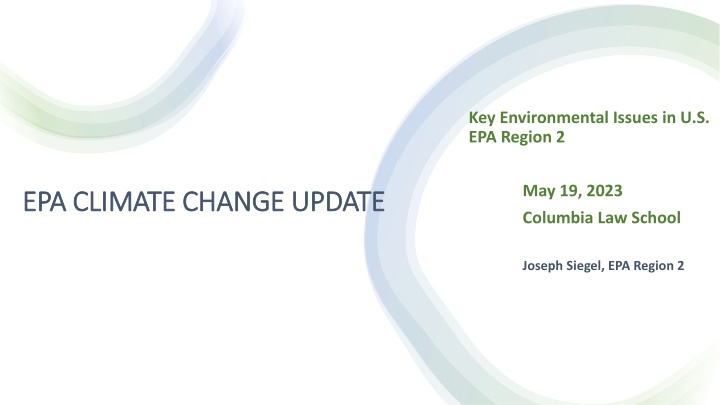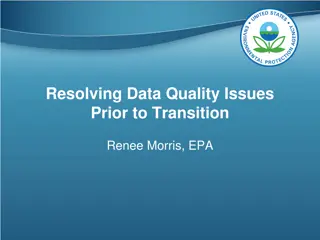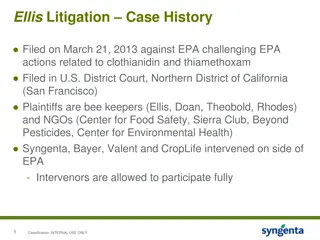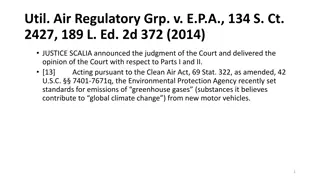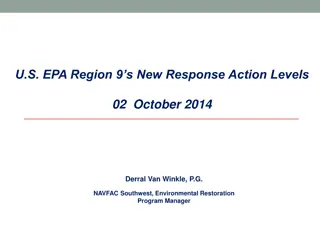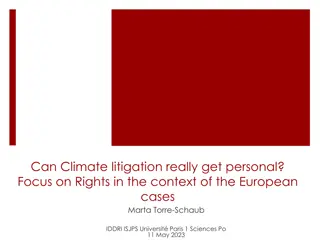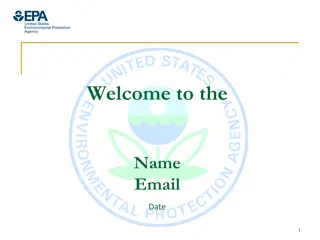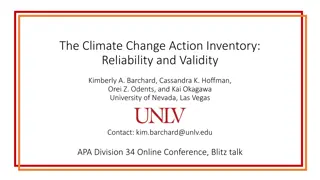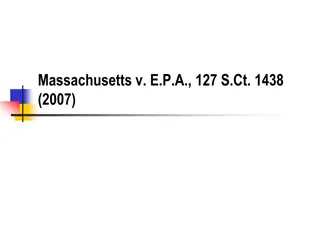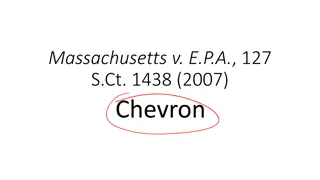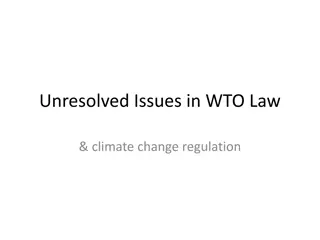EPA Climate Change Update: Key Environmental Issues and Funding Overview
EPA Region 2 presented key environmental issues in the U.S. related to climate change and introduced the Inflation Reduction Act (IRA) with significant investments to reduce emissions. The act allocates funding across various sectors such as electricity, manufacturing, energy efficiency, and transportation. EPA received substantial appropriations to support new programs aimed at greenhouse gas reduction, climate pollution reduction, environmental justice, and more.
Download Presentation

Please find below an Image/Link to download the presentation.
The content on the website is provided AS IS for your information and personal use only. It may not be sold, licensed, or shared on other websites without obtaining consent from the author.If you encounter any issues during the download, it is possible that the publisher has removed the file from their server.
You are allowed to download the files provided on this website for personal or commercial use, subject to the condition that they are used lawfully. All files are the property of their respective owners.
The content on the website is provided AS IS for your information and personal use only. It may not be sold, licensed, or shared on other websites without obtaining consent from the author.
E N D
Presentation Transcript
Key Environmental Issues in U.S. EPA Region 2 May 19, 2023 Columbia Law School EPA CLIMATE CHANGE UPDATE EPA CLIMATE CHANGE UPDATE Joseph Siegel, EPA Region 2
TOPICS Inflation Reduction Act Greenhouse Gas Regulatory Developments Adaptation Planning
IRA OVERVIEW The Inflation Reduction Act (IRA) makes historic investments in climate The Inflation Reduction Act (IRA) makes historic investments in climate action action that are expected to reduce U.S. emissions ~40% by 2030 while supporting disadvantaged communities and the clean energy industrial base. IRA investments will drive significant emissions reductions IRA investments will drive significant emissions reductions over the next decade while also laying the groundwork for long-term decarbonization of hard-to-abate sectors. EPA will play a major role in delivering these programs. EPA will play a major role in delivering these programs. The Agency received $41.5 billion in appropriated funds and expects to receive an additional $11.7 billion in future revenue from reinstating the Superfund Tax on oil and gas production. Funds from methane waste emissions charges will go to the general Treasury. 3
BREAKDOWN OF CLIMATE & ENERGY FUNDING Total Climate and Energy Funding ($, billions) Significant support for the electricity sector (e.g., Production & Investment Tax Credits), manufacturing, energy efficiency, electric vehicles, low carbon fuels.1 Tax Credits 271 Includes $41.5 billion in appropriated spending and $11.7 billion in new Superfund tax revenue. EPA 56 At least 15 other agencies received appropriated funding in the legislation. USDA and DOE were the other two major recipients. U.S. Department of Agriculture 47 Other agencies that received over $1B in appropriations include: Department of the Interior ($6.7B) Department of Transportation ($5.4B) General Services Administrator ($3.4B) Department of Commerce ($3.3B) U.S. Postal Service ($3B) Electric postal trucks! Housing and Urban Development Agency ($1B) Department of Energy 35 Other Agencies 24 1. Preliminary Joint Committee on Taxation analysis. Further CBO projections pending. Source: Senate Democrats, Joint Committee on Taxation, CBO 4
EPA PROGRAMS EPA received $41.5 billion in appropriations to support 24 new and existing programs. This makes EPA the second largest recipient of discretionary funding after the U.S. Department of Agriculture. Six new EPA programs account for 98% of this total funding: Greenhouse Gas Reduction Fund ($27 billion) Provide capital to greenhouse gas mitigation projects not currently able to access private capital, particularly in low-income and disadvantaged communities. Climate Pollution Reduction Grants ($5 billion) Provide grants at the state, local, and Tribal level to develop plans to reduce greenhouse gas emissions and implement those plans. At least one grant will go to an eligible entity in every state. Environmental and Climate Justice Block Grants ($3 billion) Fund community-based nonprofit organizations to support a wide range of climate and environmental justice activities. Reduce Air Pollution at Ports ($3 billion) Award rebates and grants for ports to purchase and install zero-emission technology and develop climate action plans. Methane Emissions Reduction Program ($1.55 billion) Fund grants and technical assistance to accelerate emissions reduction from petroleum and natural gas systems. Also establish a methane waste emissions charge starting at $900 per ton in 2024 and increasing to $1,500 per ton by 2026. Clean Heavy-Duty Vehicles ($1 billion) Provide grants, rebates, and contract support to replace heavy duty vehicles with zero emission alternatives. $400 million is specifically for nonattainment areas. 5
GREENHOUSE GAS REDUCTION FUND OVERVIEW Funding stream #1 Funding streams #2 and #3 $7 billion in competitive grants $11.97 billion and $8 billion in competitive grants Funding States, municipalities, Tribal governments, and eligible recipients (see righthand column) Eligible recipients defined as: A nonprofit that provides capital, including by leveraging private capital Does not take deposits other than from repayments and other revenue from using these grant funds Is funded by public or charitable contributions Invests in or finances projects alone or with investors Eligible Recipients Provide eligible applicants with funding that can be used as subgrants, loans, other forms of financial assistance, and technical assistance Distributed technologies on residential rooftops is specifically mentioned as an allowable use, in addition to zero-emission technologies Funds for financial and technical assistance in projects that reduce or avoid greenhouse gases and other forms of air pollution. Eligible recipients shall make: Direct investments in qualified projects Indirect investment through funding and technical assistance to establish new or support existing public, quasi-public, and nonprofit entities that provide financial assistance to qualified projects at the state, local territorial, or Tribal level, as well as community lenders Use of Funds Funds must enable low-income and disadvantaged communities to deploy or benefit from zero- emission technologies and carry out greenhouse gas reduction activities $8 billion for qualified projects in low-income and disadvantaged communities Conditions and Carve-Outs 6
EPAS IMPLEMENTATION FRAMEWORK FOR THE GREENHOUSE GAS REDUCTION FUND GREENHOUSE GAS REDUCTION FUND 4/19/2023 Clean Communities Investment Accelerator Competition: $6 Billion National Clean Investment Fund Competition: $14 Billion Solar for All Competition: $7 Billion Up to 60 grants to state, Tribal governments, municipalities and nonprofits to expand low- income and disadvantaged community solar Fund 2-3 National Nonprofits to partner with private capital providers to deliver financing Fund 2-7 hub nonprofits to rapidly build clean financing capacity
Climate Pollution Reduction Grant (CPRG) Program 1. Planning grants to develop strong climate pollution reduction strategies ($250 million) Administered through non-competitive cooperative agreements 2. Competitive implementation grants to help put plans into action ($4.6 billion) 8
CPRG: Planning Grant Allocations States: $156 million Up to $3M per state + DC + Puerto Rico Locals: $67 million Up to $1M each for the 67 most populous metropolitan areas Territories: $2 million Up to $500K each for US Virgin Islands, Guam, American Samoa, Northern Mariana Islands Tribes: $25 million Up to $500K per tribe or $1M for groups of 2 or more 9
METHANE METHANE Supplemental Proposal Supplemental Proposal- - Oil and Natural Gas Sector: Natural Gas Sector: 87 FR 74702 (Dec. 6, 2022) 87 FR 74702 (Dec. 6, 2022) Oil and
METHANE RULE: Addresses Interconnected System METHANE RULE: Addresses Interconnected System
METHANE RULE: Environmental Justice Impacts METHANE RULE: Environmental Justice Impacts
Methane RULE: BENEFITS Methane RULE: BENEFITS
GHG Motor Vehicle Rules: Light/Medium Duty GHG Motor Vehicle Rules: Light/Medium Duty 88 FR 29184 (May 5, 2023); Heavy Duty Heavy Duty 88 FR 25926 (April 27, 2023)
Projected Industry Fleet Average for Light Duty Vehicles g/mile Projected Industry Fleet Average for Light Duty Vehicles g/mile compared to current MY 2026 standard (est. in 2021) compared to current MY 2026 standard (est. in 2021)
Light and Medium Light and Medium- -Duty Vehicles: Proposed Duty Vehicles: Proposed Rule for MY 2027 Rule for MY 2027- -2032 (May 5, 2023) 2032 (May 5, 2023) Light Duty Vehicles: 56% Reduction in industry fleetwide average compared with 2026 by 2032 Medium Duty Vehicles: 44% Reduction in industry fleetwide average compared with 2026 by 2032 The vehicle technology costs of this proposal range from $180 billion to $280 billion, but the program also would have additional social benefits from fuel savings of $450 billion to $890 billion through 2055, and repair and maintenance savings (stemming from lower maintenance and repair of electric vehicles compared to gasoline vehicles) estimated through 2055 at $280 billion to $580 billion.
Heavy Heavy- -Duty Vehicles: Proposed Rule for MY Duty Vehicles: Proposed Rule for MY 2027 2027- -2032 (April 27, 2023) 2032 (April 27, 2023) Standards differentiated by vehicle type and use Allows averaging, banking and trading Avoid approximately 1.8 billion metric tons of greenhouse gas emissions from 2027 through 2055 EPA estimates that the total benefits of this proposal far exceed the total costs, by as much as $320 billion. Society would realize approximately $87 billion in climate benefits and up to $29 billion in benefits from fewer premature death and serious health effects such as hospital admissions due to respiratory and cardiovascular illnesses, and approximately $12 billion in reduced reliance on oil imports.
POWER SECTOR POWER SECTOR- - Proposed Rule (not yet published) (not yet published) Proposed Rule
POWER SECTOR: CLEAN AIR ACT Section 111 POWER SECTOR: CLEAN AIR ACT Section 111
POWER SECTOR POWER SECTOR STANDARDS STANDARDS
POWER SECTOR POWER SECTOR Benefits/Costs Benefits/Costs
ADAPTATION ADAPTATION E.O. 14008 on Tackling the Climate Crisis at Home and Abroad, Section 211 (Jan. 27, 2021) The head of each agency shall submit a draft action plan within 120 days of the date of this order that describes steps the agency can take with regard to its facilities and operations to bolster adaptation and increase resilience to the impacts of climate change.
DIRECTS EPA REGIONAL OFFICES TO UPDATE THEIR 2014 ADAPTATION PLANS
Released Oct. 6, 2022
Vulnerability Assessment Regional vulnerabilities (e.g., rising seas, high temperatures, tidal flooding) Programmatic vulnerabilities (e.g., Air Quality; Water Quality; Contaminated Sites; Use and Exposure to Toxic Chemicals; EPA s Facilities and Operations) Adaptation Plan Overview 44 Regional Priority Actions Reduce Impacts/Adapt to the identified programmatic vulnerabilities Categorized into six thematic areas Majority require additional resources Training EPA Staff Science Needs - to better inform climate change adaptation efforts
Updated science from 2014 Increased emphasis on vulnerable populations New subsection specific to Puerto Rico and the USVI, including impacts of Hurricanes Maria and Irma Updated observations from Indian Nation partners New subsection on Trauma/Mental health New subsection on conflict What s New In The Vulnerability Assessment?
Priority Actions: 6 THEMES (3) Seek Opportunities to Integrate Environmental Justice into Each of Our Climate Change Priority Actions, to the Extent Practicable (1) Advance Research, Systems and Guidance that Support Climate Adaptation in Region 2 (2) Leverage Partnerships & Conduct Outreach to Enhance Adaptative Capacity in Region 2 (4) Support the Use of Disaster Recovery Resources and Disaster Mitigation Strategies to Assist States, Local Communities, Indian Nations, and Territories in their Adaptation Efforts (5) Use our Regulatory Authorities to Expand our Work on Climate Adaptation (6) Maintaining Region 2 Facilities and Operations
THANK YOU! Joe Siegel Siegel.joseph@epa.gov
